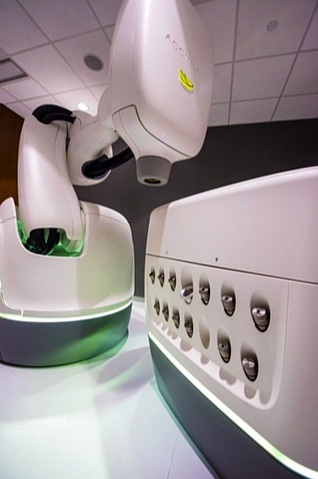David Roberge, head of radiation oncology, works in a new “superhospital” in downtown Montreal -- the “CHUM” or “Centre Hospitalier de l’Université de Montréal”. He has been performing radiosurgery for more than 15 years. Dr. Roberge currently treats patients using the latest version of the “Cyberknife” (since it installed the first Canadian Cyberknife in 2009, this is CHUM’s third iteration of this robotic device) and works with a team including a neurosurgeon, ENT surgeon, neuro-radiologists and audiologists. He gives us his opinion regarding five common questions about acoustic neuroma radiation treatments.
1. Once a patient has chosen to defer treatment, what should trigger the decision to proceed with radiation?

As with many decisions in the management of acoustic neuromas, the answer is “it depends”. The decision can be different for each patient — taking into account the size of the tumour, the age and general health condition of the patient, and the patient’s symptoms, goals and preferences.
In general, triggers for treatment can be tumour growth or new/ progressive symptoms. The dilemma will often be similar to the dilemma faced at the time of diagnosis — should I have treatment now or should I wait? On one hand, long-term outcomes (especially hearing) will be best in those patients with good cranial nerve function at the time of treatment (injury caused by the tumour during observation will often be permanent) but on the other hand, treatment itself can cause injury to the cranial nerves.
The rare circumstances where treatment “must” be performed are those where the tumour is causing symptoms by compression of the brainstem or there is a blockage of outflow of cerebrospinal fluid (hydrocephalus). Treatment should also strongly be considered for tumours with rapid growth.
In my practice, I find it useful to take the time to decide up front what the trigger for treatment will be. This will decrease anxiety at each subsequent MRI. Those triggers can be a growth rate (more than 2mm/year), a size (2cm) or a decrease in hearing.
2. When is radiation not a viable option?
There may be reasons related to the tumour or the patient who favors surgery over radiation. Size used to be an important consideration but, as years go by, the evidence for the safety of radiation to treat larger tumours is accumulating. Each clinic will have a different comfort level in treating tumours greater than 3 or even 4 cm with radiation. Independent of exact size, when the goal is to relieve pressure on brain structures or restore flow of cerebrospinal fluid, radiation is not the appropriate treatment.
There are occasional cases where, even for a trained neuro-radiologist, the diagnosis of acoustic neuroma is uncertain. In these cases, it may be best to perform surgery to treat the tumour and confirm the diagnosis.
There are diseases and genetic profiles which make an individual more sensitive to radiation. Luckily these are rare and those syndromes which lead to the highest risk of radiation injury (Ataxia Telangiectasia, Fanconi Anemia, or Nijmegen Breakage Syndrome) have other manifestations which should bring them to attention. It is important for the medical team to review the entire medical history, including apparently unrelated conditions, prior to recommending radiation. There is a budding industry of tests which purport to quantify radiation sensitivity, but these are almost never used and are probably better suited to situations where more of the body would receive radiation (such as the treatment of breast or prostate cancer). It is normal to be more reluctant to use radiation in children as they will have more years ahead of them to develop radiation-induced tumours. This will be weighed in the decision but as the absolute risk of a radiation-induced tumour will remain very small, radiosurgery can still be considered for children.
There are fewer and fewer patients who cannot undergo MRI imaging as most surgical material is now made to be MRI safe and protocols are developed to allow imaging of patients with many types of pacemakers. I also find that patients suffering from claustrophobia can almost always undergo MRI on new devices with larger bore sizes — sometimes with medication or psychological support. In extreme cases, sedation by an anesthetist can be a last resort. There do remain cases in which MRI cannot be safely obtained. In those cases, radiotherapy can still be performed but will not be ideal as targeting will be done with less precise CT imaging.
3. Under what conditions is it possible to repeat radiation?
The risks of radiation will be greater when it is repeated, and the efficacy will likely be less. As the doses of radiation used for acoustic neuroma are modest, it is often safe to repeat treatment once. Although time does allow for repair of radiation damage to normal brain, this repair is never complete, and the radiation doses will be additive.
The main concern when contemplating a second radiation treatment is so called “pseudoprogression”. It is common for a tumour to enlarge and then shrink on its own in the first years after radiation. Because of this, it almost never makes sense to radiate again in the first 2-3 years after an initial radiation treatment.
4. When is radiation done following surgery?
Tumours are not always completely removed at surgery. Sometimes this is intentional in order to preserve nerve function. The indication and timing of radiation after surgery will depend on several factors including how much tumour is left, what nerve function remains after surgery and how fast the tumour was growing prior to surgery. It is my personal preference to let the patient recover a few months and offer radiation up-front when the tumour was rapidly growing prior to surgery but wait until the first sign of regrowth for most other patients.
5. Are there any statistics about the demographics of patients undergoing radiation?
As the Canadian Cancer Registry has not included benign brain tumours, it is difficult to have good data in Canada. In the US, the most significant demographic factor in predicting whether or not a patient had radiation for an acoustic neuroma was where that patient lived. You were most likely to have radiation if you lived in New Mexico and tenfold less likely to have radiation if you lived in Utah. I would not be surprised if we found significant analogous regional difference in Canada.

Dr. David Roberge is a full professor in the division of Radiology/Radiation-oncology/Nuclear Medicine at the University of Montreal. Dr. Roberge is also editor of the journal of the Canadian Association of Radiation Oncology and reviews manuscripts for more than 25 journals. More recently, he has focused on technology in radiation oncology with an interest in advanced CT imaging.
CHUM radiation oncology has positioned itself as a leader in the theoretical and clinical investigation of dual energy CT imaging in radiation treatment planning due to his leadership. Dr. Roberge’s vision is to develop at CHUM new treatment paradigms and optimal implementations of modern radiotherapy technologies.
